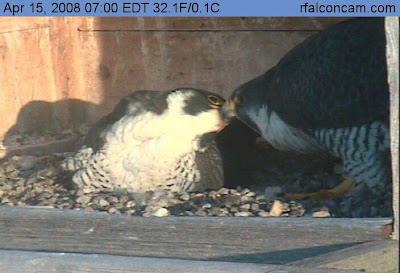












 Breeding the day away in the sunshine. Things settled down nicely overhere. After all the problems with Scout, 4 eggs are in the scrape. We just have to wait and see if three will hatch, or maybe four. It will be some time before we know. Estimated hatchday not before May 13.
Breeding the day away in the sunshine. Things settled down nicely overhere. After all the problems with Scout, 4 eggs are in the scrape. We just have to wait and see if three will hatch, or maybe four. It will be some time before we know. Estimated hatchday not before May 13.

 Here in the Netherlands all the watchers of De Mortel are getting excited now that hatchday is near. Sunday will probably be the day the first eyas ever for our S2 will hatch. That will be so awesome.
Here in the Netherlands all the watchers of De Mortel are getting excited now that hatchday is near. Sunday will probably be the day the first eyas ever for our S2 will hatch. That will be so awesome.




 Thank you so much for zooming in again on our beloved peregrines of Derby.
Thank you so much for zooming in again on our beloved peregrines of Derby.

 Giotto and Monna Tessa will be welcoming their 4 eyases on April 21, next Monday. So just a few more days to go, and little sweet eyases will be born here as well.
Giotto and Monna Tessa will be welcoming their 4 eyases on April 21, next Monday. So just a few more days to go, and little sweet eyases will be born here as well.


 4 Beautiful eggs with inside growing embryo's. They are now around 22 days old. This picture shows what the embryo's look like now, at this age. A real little chicklet. Notice the enormous eyes compared to the size of the skull.
4 Beautiful eggs with inside growing embryo's. They are now around 22 days old. This picture shows what the embryo's look like now, at this age. A real little chicklet. Notice the enormous eyes compared to the size of the skull.


" We need another, and a wiser, perhaps a more mystical,
concept of animals.
Remote from universal nature and living by complicated artifice,
man in civilization surveys the creature through the glass of his knowledge
and sees thereby a feather magnified and the whole image in distortion.
*
We patronize them for their incompleteness,
for their tragic fate of having taken form so far below ourselves.
And therein we err, and greatly err.
For the animal shall not be measured by man.
*
In a world older and more complete than ours
they move finished and complete,
gifted with extensions of the senses we have lost or never attained,
living by voices we shall never hear.
*
They are not brethren.
They are not underlings.
They are other nations, caught with ourselves in the net of life and time,
fellow prisoners of the splendor and travail of the earth.”
*
Henry Beston




With special thanks to:
Chris & Chad Saladin
